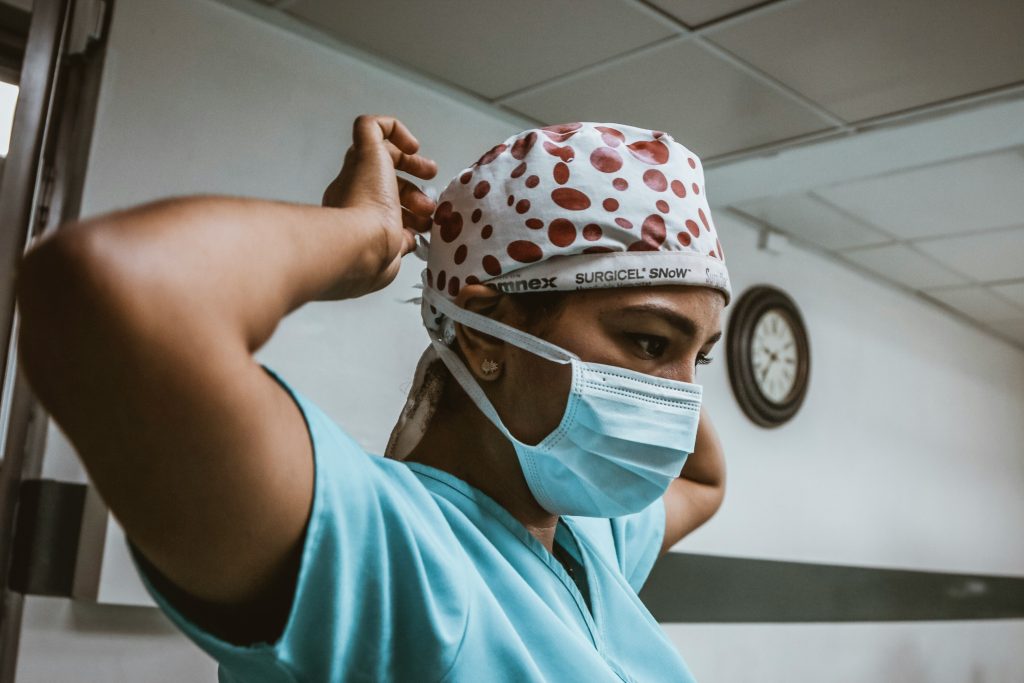
The recent COVID-19 pandemic exposed the stark reality of some of the challenges faced by individuals working within healthcare, and how being a healthcare worker (HCW) means dealing with burnout, moral injury (a psychological and emotional response to events/ actions that violate a person’s moral beliefs & values; Shay, 2014; Watson et al., 2020), post-traumatic stress disorder, stress, anxiety, depression (Chirico et al., 2021) and suicidal ideation (Dutheil et al., 2019). However, even prior to the pandemic, there were signs indicating that HCWs were under considerable stress, as burnout and psychiatric morbidity among doctors was already consistently reported at worrying levels (e.g., Imo, 2017).
However, there is a lack of evidence regarding potential differences in common mental disorders (CMD) and suicidal ideation (SI) across consultant doctors in different medical specialties. Consultant doctors are in a position of considerable responsibility; their wellbeing, both physical and mental, is of importance not only for their individual quality of life but also for the delivery of high-quality patient care. To that end, Petrie et al. (2023) analysed the data from the 2013 Beyond Blue National Mental Health Survey of Doctors and Medical Students in Australia (Wu et al., 2013) to determine whether likely CMD and SI varied between medical specialties.

As the wellbeing of consultant doctors impacts their quality of life as well as the care they can provide to patients, it is important to learn more about differences in mental health and suicidal ideation between specialties, to identify who may need additional support.
Methods
This research is a secondary analysis of existing cross-sectional data on 7,037 employed (part-time or full-time) Australian consultant doctors in any specialty from the 2013 survey (successfully completed by 12,252 doctors out of the 42,924 invited, resulting in a 27% response rate). The participants’ demographic profiles were deemed to be representative of the wider Australian medical workforce in terms of age, gender and geographic location distribution.
The data used in this study included:
- Caseness of CMD, measured with the General Health Questionnaire (GHQ-28). The authors used a binary scoring method where any score ≥5 indicated a likely case of CMD.
- SI, measured as positive response to one yes/no question: “During the last 12 months, have you had thoughts of taking your own life?”.
- Demographic and work-related information, including gender, age group (26-30, 31-40, 41-50, 51-60, ≥61), marital status, number of children, work location, and medical specialty.
Statistical analyses included Chi-square tests to assess specialty-related relationships, univariate logistic regression for potential confounders, and adjusted multivariate logistic regression controlling for factors like age, gender, marital status, and work location. Odds ratios (ORs) and confidence intervals (CIs 95%) were calculated and are reported.
Results
Participants characteristics
- The majority of respondents were men (58.2%), between 41-60 years (60.1%) and in a committed relationship/married (88%) with children (cumulative total: 68.3%).
- General Practitioners (GPs) were the largest group (39.5%), followed by Internal Medicine (13.2%) and Anaesthetics (8.6%).
- Most worked in a metropolitan area (60.7%), at a group practice or hospital (cumulative total: 77.6%).
Self-reported CMD and SI prevalence
- 23% reported likely CMD, which is higher than rates for the general working population in Australia in 2014, which was 12% (Australian Bureau of Statistics [ABS], 2015).
- 9% reported SI experience during the last 12 months, significantly higher than the general population in Australia in 2020-2021 (3%, ABS, 2021)
Factors affecting self-reported CMD presence
- Women were 1.5 times more at risk of reporting CMD compared to men (OR = 1.53, 95% CI [1.37 to 1.72]).
- Doctors with children were also at risk, with the highest risk among those with ≥5 children (OR = 2.79, 95% CI [1.36 to 5.73]) compared to those with 1-2 children (OR = 1.54, 95% CI [1.33 to 1.79]) and with 3-4 children (OR = 1.38, 95% CI [1.13 to 1.67]).
- Doctors aged ≥61 years old were less likely to report possible CMD than doctors 26-30 years old (OR = 0.32, 95% CI [0.18 to 0.58]), as well as married/in committed relationship compared to their single counterparts (OR = 0.58, 95% CI [0.46 to 0,73])
- Adjusting for all the above, surgeons had lower odd of likely CMD compared to GPs (OR = 0.73, 95% CI [0.54 to 0.97]).
Factors affecting self-reported SI
- Doctors living in rural/regional areas were more likely to report SI (OR = 1.28, 95% CI [1.09 to 1.50]) compared to counterparts in metropolitan areas.
- Married/in committed relationship doctors were less likely to report SI compared to their single counterparts (OR = 0.42, 95% CI [0.32 to 0.56]).
- Adjusting for all above, paediatrics doctors were almost one and a half times (OR = 1.45, 95% CI [1.09 to 1.93]) and anaesthetics doctors almost two times more likely (OR = 1.88, 95% CI [1.02 to 3.47]) to report SI compared to GPs. and ).

23% of doctors reported a likely common mental disorder, and 9% reported experiencing suicidal ideation over the past 12 months. Both statistics are higher than in the general Australian working population.
Conclusions
The authors concluded that doctors in paediatrics and anaesthetics were more likely to experience SI compared to GPs in Australia – but these two specialties were not linked to higher risk of reported CMD symptoms. On the other hand, Australian surgeons were less likely to report higher CMD symptoms levels compared to GPs.
Specific aspects of paediatrics might contribute to higher SI risk, such as dealing with sensitive issues like child abuse or neglect, as well as facing the pressure of making critical decisions for patients who may not be able to articulate their symptoms or concerns clearly due to their age. For anaesthetics, higher SI is consistent with the wider literature showing higher suicide incidence rates among anaesthesiologists compared to other specialties (Rodrigues et al., 2021).

Being married or in a committed relationship reduced the odds of experiencing common mental disorders and suicidal ideation. However, anaesthetists were almost two times more likely to report experiencing suicidal ideation compared to GPs.
Strengths and limitations
The study by Petrie et al. (2023) explored a crucial issue, as it is well documented that the wellbeing and mental health of healthcare workers (HCWs) is the cornerstone of patient safety and quality of care, which has ripple effects for communities and wider society. It is the first study to the authors’ knowledge to examine CMD in medical doctors in terms of specialty.
However, it is unknown how representative the sample was of the mental health status of the Australian medical workforce, despite having similar demographics. The “Healthy Worker Effect” which in the past was identified as a source of bias in occupational health studies (Li & Sung, 1999), often appears in research across HCWs in the form of “self-selection”. For example, burnt-out HCWs may be less inclined to take part in voluntary research and/or interventions due to self-selection bias. Moreover, the stigma around mental health makes it less likely that doctors will disclose experiencing distress or SI even in an anonymous survey, which is rooted in a culture of silence that is prevalent within healthcare organisations (Lainidi et al., 2023).
While the study identified some significant relationships between specialty and likely reported CMD or SI, the cross-sectional nature of the data means that we cannot assume causality. Other potential confounding factors were not examined, such as those related to personality differences or the work environments of the participants (e.g., supervisor relationship, staff shortages).
As the study primarily focuses on Australian doctors, the findings may not be directly applicable to doctors in other countries or healthcare systems. Therefore, any comparisons with findings from the NHS should be made with caution. Moreover, the study does not provide any information on LGBTQ+ or Black, Asian and Minority Ethnic groups, who, as revealed during COVID, have a significantly increased risk of mortality when compared to white HCWs (Kursumovic et al., 2020).
Finally, the data used for this study was collected in ten years ago in 2013. Since then, healthcare systems globally have suffered due to the COVID-19 pandemic, the detrimental effects of which are yet to be successfully addressed. The Office of National Statistics reported that in the most recent available data for Suicides by occupation there were 32 suicides among HCWs in 2020 and 33 suicides in 2021. Taking potential changes over time into consideration, this study highlights that concerns regarding CMD and SI in HCWs predates COVID-19, pointing towards occupational and aspects of organisational culture that have been demanding our attention for a very long time.

While the current study identified higher risks within specific medical specialties, we do not know if there are any common underlying factors linked to job demands and interpersonal dynamics, which could have important implications for developing solutions.
Implications for practice
The findings of this study have important implications for research, policy, and practice. In terms of policy, while the prevalence of CMD and SI was broadly similar across medical specialties, acknowledging that different specialties have differing demands in physical and psychological resources is a necessary step to inform tailored policy. Findings from the current study suggest that paediatric and anaesthetic doctors are particularly in need of support for SI, whilst GPs may need additional support for CMDs.
Within this, it is important to recognise that poor mental health and wellbeing among consultant doctors has significant financial consequences. In the UK, a recent report from the International Public Policy Observatory estimates that the financial cost to the NHS of poor wellbeing in staff is £12.1 billion a year (Daniels et al., 2022). Addressing the mental wellbeing of HCWs means freeing up resources to improve conditions for both staff and patients in healthcare facilities, and should be considered as a priority for policymakers.
Unfortunately, the prevalence of CMD and SI within this group suggests an insufficient emphasis on prioritising the wellbeing of HCWs. A comprehensive approach that includes providing support at the individual level, whilst also implementing broader solutions at the unit and organisational levels, is needed. This shift should involve replacing a culture of blame and expectations for HCWs to keep going “no matter what” with one that prioritises creating healthy workplaces for healthy workers. Practically, clinical leaders and managers should ensure that appropriate supervision is provided to their staff, and that there is widespread awareness regarding psychological safety and the availability resources for supporting mental health and SI.

Prioritising healthcare workers’ wellbeing is crucial, as highlighted by the £12.1 billion annual cost in the UK and the alarming statistic of 1 in 10 NHS workers experiencing suicidal thoughts during the pandemic. .
Statement of interests
I have no competing interests to declare.
Links
Primary paper
Petrie, K., Sanatkar, S., Shand, F., & Harvey, S. B. (2023). Common mental disorder and suicidality among doctors: Differences by specialty. Occupational Medicine, 73(5), 249–256.
Other references
Chirico, F., Ferrari, G., Nucera, G., Szarpak, L., Crescenzo, P., & Ilesanmi, O. (2021). Prevalence of anxiety, depression, burnout syndrome, and mental health disorders among healthcare workers during the COVID-19 pandemic: A rapid umbrella review of systematic reviews. Journal of Health and Social Sciences, 6(2), 209-220.
Daniels, K., Connolly, S., Woodard, R., van Stolk, C., Patey, J., Fong, K., … & Herd, M. (2022). NHS staff wellbeing: Why investing in organisational and management practices makes business sense. The International Public Policy Observatory. Retrieved from
Dutheil, F., Aubert, C., Pereira, B., Dambrun, M., Moustafa, F., Mermillod, M., … & Navel, V. (2019). Suicide among physicians and health-care workers: A systematic review and meta-analysis. PloS One, 14(12), e0226361.
Australian Department of Health (2015). National Health Workforce Dataset (NHWDS) medical practitioners. Retrieved 2022, from https://hwd.health.gov.au/resources/information/nhwds.html
Imo, U. O. (2017). Burnout and psychiatric morbidity among doctors in the UK: A systematic literature review of prevalence and associated factors. BJPsych Bulletin, 41(4), 197-204.
Kursumovic, E., Lennane, S., & Cook, T. M. (2020). Deaths in healthcare workers due to COVID‐19: the need for robust data and analysis. Anaesthesia, 75(8), 989.
Lainidi, O., Jendeby, M. K., Montgomery, A., Mouratidis, C., Paitaridou, K., Cook, C., … & Karakasidou, E. (2023). An integrative systematic review of employee silence and voice in healthcare: what are we really measuring?. Frontiers in Psychiatry, 14, 1111579.
Li, C. Y., & Sung, F. C. (1999). A review of the healthy worker effect in occupational epidemiology. Occupational Medicine, 49(4), 225-229.
Rodrigues, J. V. D. S., Pereira, J. E. G., Passarelli, L. A., Guatura, G. M., & El Dib, R. (2021). Risk of mortality and suicide associated with substance use disorder among healthcare professionals: A systematic review and meta-analysis of observational studies. European Journal of Anaesthesiology, 38(7), 715-734.
Shay, J. (2014). Moral injury. Psychoanalytic Psychology, 31(2), 182.
Watson, P., Norman, S. B., Maguen, S., & Hamblen, J. (2020). Moral injury in health care workers. National Center for PTSD. Retrieved from https://www.ptsd.va.gov/professional/treat/cooccurring/moral_injury_hcw.asp
Wu, F., Lawrence, D., Ireland, M., & Hafekost, K. (2013). National mental health survey of doctors and medical students. Beyond Blue. Retrieved from https://espace.curtin.edu.au/bitstream/handle/20.500.11937/90008/89832.pdf?sequence=2
Photo credits
- Photo by Patty Brito on Unsplash
- Photo by Luis Melendez on Unsplash
- Photo by Justin Follis on Unsplash
- Photo by SJ Objio on Unsplash
- Photo by Philip Veater on Unsplash
